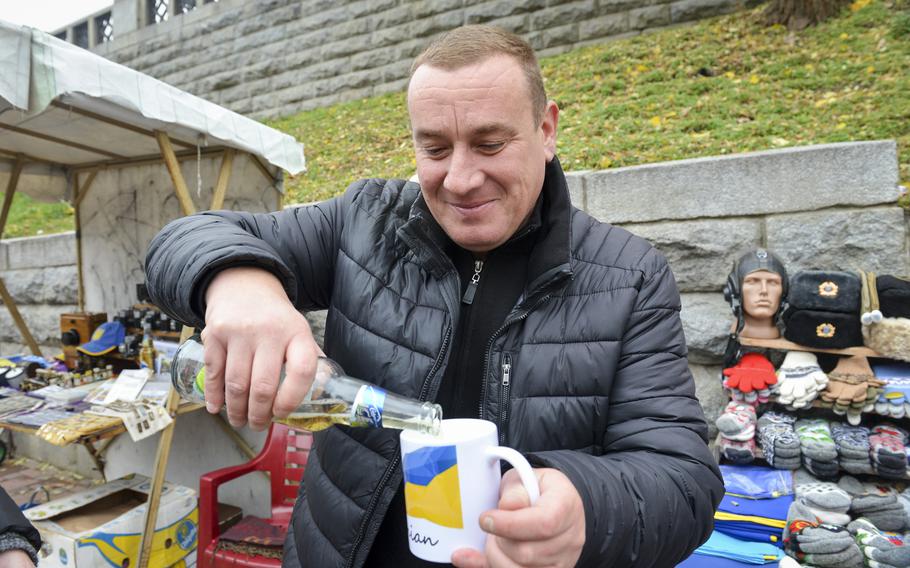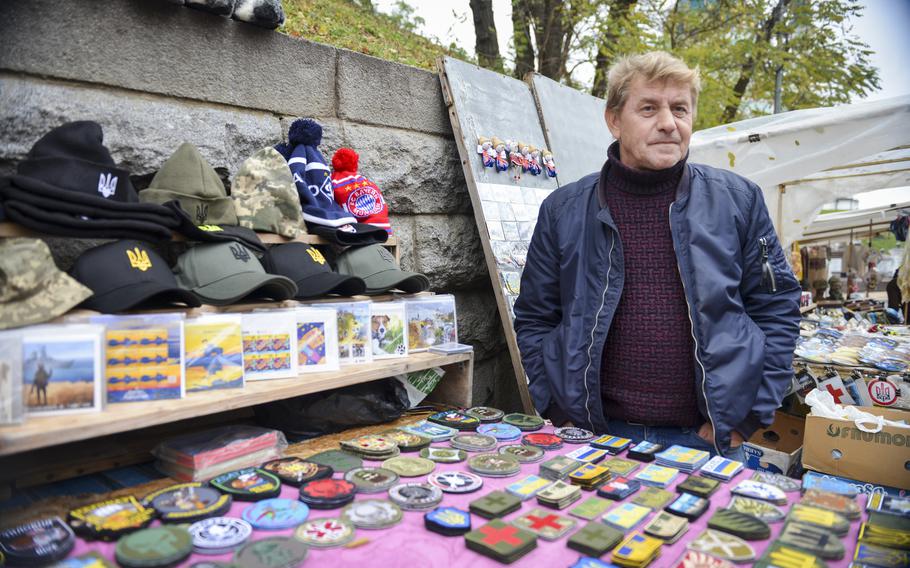
Oleg Boika pours a bottle of beer into a mug as an air raid siren blares in Kyiv, Ukraine, on Oct. 27, 2022. The street vendor says he cannot abandon his cart to get to a shelter during alerts, so he and other hawkers said they can only look up at the sky and hope for the best. (J.P. Lawrence/Stars and Stripes)
KYIV, Ukraine — The wail of an air raid siren beckons city residents to seek shelter several times a day, but the open-air vendors of Volodymyrska Street stay put.
A bevy of Ukrainian souvenirs is splayed out on tables and not even the threat of a missile or drone strike will make them leave behind the memorabilia — an important source of their livelihood.
“We can’t go anywhere,” said Tetiana Zhornova, ignoring yet another alarm on Thursday.
Instead, the vendors look up at the sky and hope for the best. They turn their gaze to St. Andrews Church on the left, in the direction of neighboring Belarus, an oft-used launching pad for Russian strikes. They check their phones for news updates.
A few weeks ago, Sergiy Zhornavoy and Oleg Boika saw a missile whistling overhead during the fiercest bombardment of Ukraine’s capital city since the early days of Russia’s full-scale invasion in February.
Zhornavoy jokes that they run off to buy vodka to calm their nerves amid the sirens. Boika said he’s more afraid to ride a train from Kyiv to Lviv in the west than to stand out in the open.
Zhornova takes solace in the vendors’ lofty location: sandwiched between the gold-and-teal-domed St. Andrews Church and St. Sophia’s Cathedral, a UNESCO World Heritage Site, on one of the oldest streets in the city.
“There are no strategic targets here,” Zhornova said. “These are important, historic sites, I don’t think they’ll be hitting anywhere here and destroying all of this.”
She said she feels safer outside than at home, where three hits on her neighborhood have left a pair of cracks in her recently wallpapered apartment wall. Earlier this month she watched a self-destructing drone zoom by her window. Thirty seconds later she heard an explosion.
“You sit in your apartment and you don’t know where the rocket is flying but here — I don’t think it will land right here,” Zhornova said.
The vendors spend up to 10 hours a day, every day, hawking clothes, mugs, decorative plates, flags, flasks and other items commemorating Ukraine’s rich history and defining moments of the eight-month war. The area had been a prime tourist destination, and these stalls were once teeming with visitors, many from the United States, Europe and Turkey, before Russia stoked unrest in Ukraine’s east in 2014, Boika said.
Foot traffic slowed in the years since, though dignitaries like the late Sen. John McCain, R-Ariz., and celebrities like the Kyiv-born American actress Milla Jovovich made a point to stop by and spend money. McCain bought vyshyvankas, traditional Ukrainian embroidered shirts, during every visit, Boika said.
Business plummeted fivefold after Russia’s full-scale invasion, said Zhornova. Some 90% of the vendors who used to spill onto the roadway on Volodymyrska Street are gone. Those who remain — just a handful — either have a financial cushion to weather drops in income or lack other options.
“There is no other work,” said Zhornova. “The minimum salary that other jobs offer I can make here but there is nothing that pays more.”

Sergiy Zhornavoy sells unit patches and other wartime memorabilia at his souvenir cart on Volodymyrska Street, one of the oldest boulevards in Kyiv, Ukraine, on Oct. 27, 2022. The vendors, who have sold tchotchkes and trinkets on their street for decades, said their most popular items now are related to the Ukrainian military. (J.P. Lawrence/Stars and Stripes)
Boika, Zhornavoy and Zhornova have been selling souvenirs almost as long as Ukraine has been an independent nation. Despite the collapse of the Soviet Union in 1991, they offered customers Russian nesting dolls and Soviet memorabilia for decades.
That stopped the day Russian tanks rolled into Ukraine, Boika said. He threw all his Soviet Union flags in the trash and sold off the remaining stocks of Soviet goods online.
“We will never again sell matryoshkas,” he said, using the Russian word for the nesting dolls. “You can’t come back from this, not for 100 years or even longer.”
The most popular items today are related to the Ukrainian military. Patches and insignia with the Ukrainian trident coat of arms and other military symbols sell well, as do hats and socks now that temperatures are falling. Zhornova said other best sellers include mugs bearing the image of Patron, Ukraine’s famed mine-sniffing Jack Russell Terrier, and the warship Moskva, flagship of Russia’s Black Sea fleet that sank in April after explosions presumably caused by Ukrainian missiles.

Oleg Boika pours a bottle of beer into a mug as an air raid siren blares in Kyiv, Ukraine, on Oct. 27, 2022. The street vendor says he cannot abandon his cart to get to a shelter during alerts, so he and other hawkers said they can only look up at the sky and hope for the best. (J.P. Lawrence/Stars and Stripes)
Most customers are members of the military, both Ukrainians and foreign fighters, or people buying gifts for Ukrainian refugees abroad, she said.
Zhornova said she too thought about fleeing Kyiv with her 27-year-old son and cat when she saw the sky light up red during Russia’s March assault on Bucha, a town 20 miles outside the capital, but now she intends to stay. She’s grown accustomed to the sounds and sights of war. While she still worries when she hears an air raid siren, she’s somewhat numbed to that as well.
When the war ends, Zhornova said she will cover the cracks in her apartment wall with new wallpaper. Or perhaps the wall will crumble and she will get to enjoy an enlarged communal living space with her neighbor, she joked.
“You can’t live without humor,” she said. “We won’t cry even in war. You need to hold yourself together, despite the enemy.”